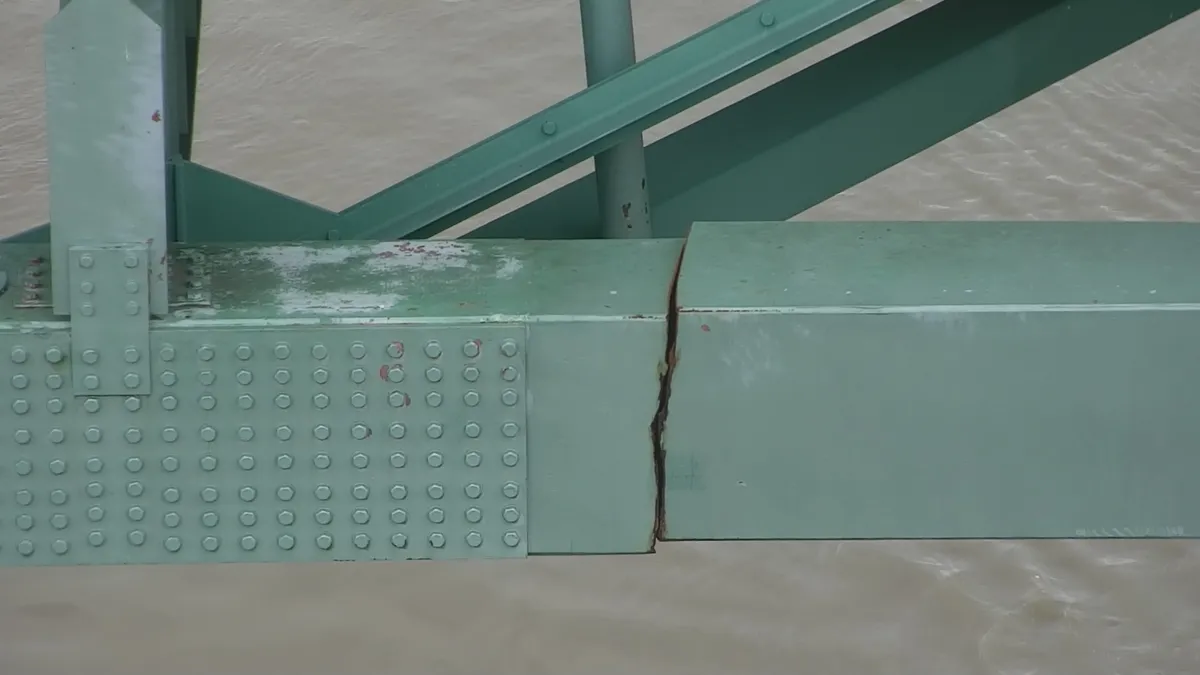A series of infrastructure-related complications over the last week in the eastern U.S. have slowed freight movement and increased surcharges, showcasing how quickly these problems can cascade through the supply chain.
Last week, Michael Baker International, a contractor for the Arkansas Department of Transportation, was inspecting I-40 Hernando de Soto Bridge over the Mississippi River when it found a crack running through a steel support beam.
The bridge, opened in 1973, closed as ArDOT worked with the Tennessee Department of Transportation to investigate the damage and "make sure the bridge is safe for motorists before we reopen it," the agency posted on Twitter.
The roadway over the Mississippi is an important link in the national supply chain, allowing freight movement between the East Coast and Southwest and from the Midwest to the Gulf Coast. It carried more than 35,000 vehicles each day. The traffic from the closed bridge is being diverted to the I-55 bridge three miles away, which carries about 40,000 vehicles per day, according to figures from the Bureau of Transportation Statistics.
"Rerouting traffic from the I-40 crossing to the nearby I-55 bridge is creating significant travel time increases, costing tens of thousands of trucks and commuters each day delays greater than an hour," BTS said in a release on Monday.
The Arkansas Trucking Association estimates a cost of $2.4 million daily to the trucking industry for each day the bridge is closed.
A spokesperson for FedEx, which is headquartered in Memphis on the Tennessee side of the bridge, said the impact "has been minimal to date, but we have implemented contingency plans to lessen any potential impacts on service."
But it was not just road traffic that was interrupted. The waterway that flows beneath the bridge is also an important freight artery that carries 470,323 short tons of freight every day, pulled on barges up and down the Mississippi. The waterway was closed for three days as the agencies determined if traveling under the bridge was safe for marine traffic. The closure created a backup of 62 tug boats carrying 1,058 barges. The most common commodities carried through this part of the river are soybeans, distillate fuel oil and corn.
According to @USCGHeartland the back up in river traffic was cleared late yesterday.
— Nichole Lawrence (@NicLawrenceTDOT) May 16, 2021
????from @mpdMemphis pic.twitter.com/AVODw8aziG
A Coast Guard spokesperson said in an email Tuesday that the backlog of vessels has been cleared.
Had the waterway remained closed, it could have created more of a headache than the closure of the bridge, according to Thomas Goldsby, the Haslam chair of logistics and co-faculty director of the Global Supply Chain Institute at the University of Tennessee's Haslam College of Business.
"There is no alternate route to the Mississippi River," Goldsby said. "And so if that had been an extended shutdown, that was going to cause some very severe problems on a transportation mode that frankly, most people don't think that much about."
Even a short delay had a big impact on the carriers that operate the waterway.
"It has a huge impact on us, on a daily basis," Ken Groth, director of organization development for American Commercial Barge Line, told the Memphis Business Journal last week. "We’re talking thousands and thousands of dollars a day, per boat."
Groth said it could take days to iron out delays caused by the closure.
ArDOT will conduct a review of bridges, after drone video surfaced showing the fracture was visible in 2019. The employee responsible for the inspections in 2019 and 2020 did them incorrectly, ArDOT Director Lorie Tudor said at a press conference Monday. "This employee has been terminated as of this morning," Tudor said.
As ArDOT and TDOT made announcements about the I-40 bridge last week, citizens up and down the East Coast scrambled to fuel their cars as a different infrastructure issue caused concern about the availability of gas. (Despite experts assuring there was plenty available.) Colonial Pipeline shut down as a result of a ransomware attack, underscoring "years of underinvestment" in protecting critical infrastructure, according to Cybersecurity Dive.
Transportation Secretary Pete Buttigieg says the Colonial pipeline cyberattack and the Texas power grid failure were "two major wake-up call experiences" in 2021 that showed the U.S. must "make sure that we have the most resilient and flexible infrastructure for the future" pic.twitter.com/trwBqGYdpP
— CBS News (@CBSNews) May 12, 2021
The rush to the tanks sent gas prices ticking upward. This then led to increases in UPS' fuel surcharges, which are tied to average highway diesel fuel prices, highlighting how these issues can all come back to affect shippers and carriers.
The I-40 bridge fracture and the Colonial Pipeline attack are the latest examples of what supply chain professionals already know: infrastructure is vital for the flow of goods. The supply chain is not broken. Months of high demand for freight and shipping led to capacity issues, yet the supply chain has still managed to move goods around the world during a pandemic. But it needed infrastructure to make it happen, from pipelines to bridges to gantry cranes.
The events over the last week also came as President Joe Biden works to sell a massive infrastructure bill, spending that experts say could be important for ensuring the nation's supply chain continues to function.
"With regard to the bill that's coming together. I think it puts a lot of wind in the sails," Goldsby said. "We've been needing to put more than band-aids on our infrastructure."























